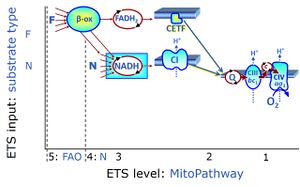Difference between revisions of "FN"
| (4 intermediate revisions by 3 users not shown) | |||
| Line 3: | Line 3: | ||
|description=[[File:SUIT-catg FN.jpg|right|300px|F-junction]] | |description=[[File:SUIT-catg FN.jpg|right|300px|F-junction]] | ||
FN is induced in mt-preparations by addition of [[NADH]]-generating substrates ([[N-pathway control state]], or CI-linked pathway control) in combination with one or several fatty acids, which are supplied to feed electrons into the [[F-junction]] through [[fatty acyl CoA dehydrogenase]] (reduced form [[FADH2]]), to [[electron transferring flavoprotein]] (CETF), and further through the [[Q-junction]] to [[Complex III]] (CIII). FAO not only depends on electron transfer through the F-junction (which is typically rate-limiting), but simultaneously generates FADH<sub>2</sub> and NADH and thus depends on [[N-junction]] throughput. Hence FAO can be inhibited completely by inhibition of [[Complex I]] (CI). This physiological substrate combination is required for partial reconstitution of [[TCA cycle]] function and convergent electron-input into the [[Q-junction]], to compensate for metabolite depletion into the incubation medium. FS in combination exerts an [[additive effect of convergent electron flow]] in most types of mitochondria. | FN is induced in mt-preparations by addition of [[NADH]]-generating substrates ([[N-pathway control state]], or CI-linked pathway control) in combination with one or several fatty acids, which are supplied to feed electrons into the [[F-junction]] through [[fatty acyl CoA dehydrogenase]] (reduced form [[FADH2]]), to [[electron transferring flavoprotein]] (CETF), and further through the [[Q-junction]] to [[Complex III]] (CIII). FAO not only depends on electron transfer through the F-junction (which is typically rate-limiting), but simultaneously generates FADH<sub>2</sub> and NADH and thus depends on [[N-junction]] throughput. Hence FAO can be inhibited completely by inhibition of [[Complex I]] (CI). This physiological substrate combination is required for partial reconstitution of [[TCA cycle]] function and convergent electron-input into the [[Q-junction]], to compensate for metabolite depletion into the incubation medium. FS in combination exerts an [[additive effect of convergent electron flow]] in most types of mitochondria. | ||
|info=[[Electron transfer-pathway state]], [[Gnaiger | |info=[[Electron-transfer-pathway state]], [[Gnaiger 2020 BEC MitoPathways]] | ||
}} | }} | ||
Communicated by [[Gnaiger E]], edited 2019-01-22 by [[Komlodi T]]. | Communicated by [[Gnaiger E]], edited 2019-01-22 by [[Komlodi T]]. | ||
| Line 16: | Line 10: | ||
::::» [[Fatty acid oxidation]] | ::::» [[Fatty acid oxidation]] | ||
::::» [[N-junction]] | ::::» [[N-junction]] | ||
::::» [[F(N)]] | ::::» [[Fatty acid oxidation pathway control state|F(N)]] | ||
::::» [[OctPM]] | |||
::::» [[OctPGM]] | |||
== FN | == FN<sub>''L''</sub> == | ||
FN pathway in the LEAK state can be evaluated in the following SUIT protocols: | |||
== FN<sub>''P''</sub> == | |||
FN pathway in the OXPHOS state can be evaluated in the following SUIT protocols: | |||
:::*[[SUIT-002]] | |||
::::* DL-Protocol for isolated mitochondria and tissue homogenate (mt): [[SUIT-002 O2 mt D005]] | |||
::::* DL-Protocol for permeabilized fibers (pfi): [[SUIT-002 O2 pfi D006]] | |||
::::* DL-Protocol for permeabilized cells (pce): [[SUIT-002 O2 ce-pce D007]] | |||
:::*[[SUIT-005]] | |||
::::* DL-Protocol for permeabilized fibers (pfi):[[SUIT-005 O2 pfi D011]] | |||
:::*[[SUIT-015]] | |||
:::*[[SUIT-016]] | |||
:::*[[SUIT-017]] | |||
== FN | == FN<sub>''E''</sub>== | ||
FN pathway in the ET state can be evaluated in the following SUIT protocols: | |||
:::*[[SUIT-019]] | |||
: | |||
:::[[SUIT- | |||
== | {{MitoPedia concepts | ||
|mitopedia concept=Respiratory state, SUIT state, Recommended | |||
}} | |||
{{MitoPedia topics | |||
|mitopedia topic=EAGLE | |||
}} | |||
Latest revision as of 19:57, 1 January 2021
Description
FN is induced in mt-preparations by addition of NADH-generating substrates (N-pathway control state, or CI-linked pathway control) in combination with one or several fatty acids, which are supplied to feed electrons into the F-junction through fatty acyl CoA dehydrogenase (reduced form FADH2), to electron transferring flavoprotein (CETF), and further through the Q-junction to Complex III (CIII). FAO not only depends on electron transfer through the F-junction (which is typically rate-limiting), but simultaneously generates FADH2 and NADH and thus depends on N-junction throughput. Hence FAO can be inhibited completely by inhibition of Complex I (CI). This physiological substrate combination is required for partial reconstitution of TCA cycle function and convergent electron-input into the Q-junction, to compensate for metabolite depletion into the incubation medium. FS in combination exerts an additive effect of convergent electron flow in most types of mitochondria.
Abbreviation: FN
Reference: Electron-transfer-pathway state, Gnaiger 2020 BEC MitoPathways
Communicated by Gnaiger E, edited 2019-01-22 by Komlodi T.
FNL
FN pathway in the LEAK state can be evaluated in the following SUIT protocols:
FNP
FN pathway in the OXPHOS state can be evaluated in the following SUIT protocols:
-
- DL-Protocol for isolated mitochondria and tissue homogenate (mt): SUIT-002 O2 mt D005
- DL-Protocol for permeabilized fibers (pfi): SUIT-002 O2 pfi D006
- DL-Protocol for permeabilized cells (pce): SUIT-002 O2 ce-pce D007
- DL-Protocol for permeabilized fibers (pfi):SUIT-005 O2 pfi D011
-
FNE
FN pathway in the ET state can be evaluated in the following SUIT protocols:
MitoPedia concepts:
Respiratory state,
SUIT state,
Recommended
MitoPedia topics:
EAGLE

